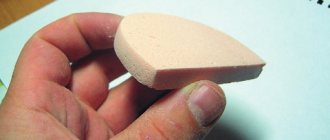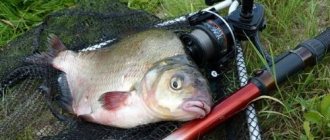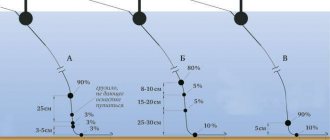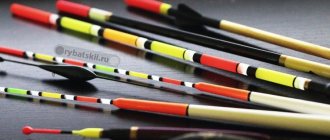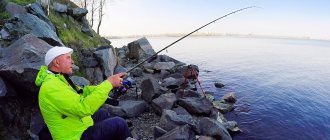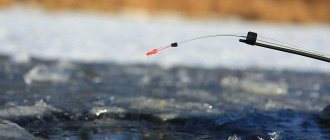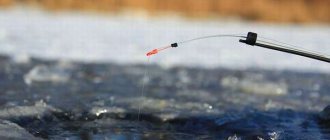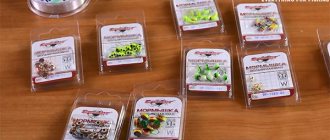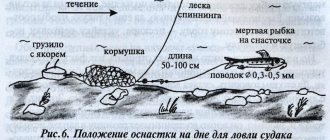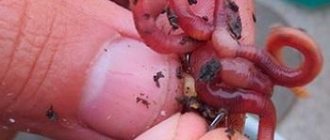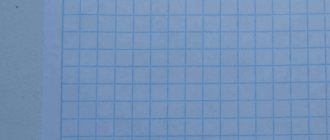To successfully fish in the current, you need to select floats of a certain shape. Their variety is very great, but, for example, the common type of “goose feather” will not work, since the force of the current will constantly lay it on its side.
As you know, the upper part of the float rod is called the antenna, while below the body itself there is a keel, thanks to which the float can be in the correct vertical position. By additionally weighing the keel with a weight, you will get a stable float that can resist even strong currents.
Ordinary floats that do not have a special coating are not visible in the dark; special floats for night fishing come to the rescue. How do they work and what are they? Read the article at the link.
Which float shape to choose for the current
The body of the float used for fishing in the current must be located above the middle of the rod and fixed on the fishing line at two points at once, above and below. Often a pair of nipple rubber bands are used for fixation. Although it is even better if the line is passed directly through the float along with the rod. With this option, it will be more convenient to control the tackle during wiring.
Floats, the body of which increases in diameter from top to bottom, are appropriate to use primarily for catching those fish that most often lift the tackle upward when biting. When the bottom of the reservoir is rocky or simply uneven, floats with an extended upper body are used. For fishing in strong currents, stable floats with a more voluminous but short body are suitable.
Choosing a float for fishing in the current
Exposure to water flow can change the behavior of the float beyond recognition. That is why for river fishing it is recommended to choose special floats suitable for use in currents.
If you are used to fishing in still water, then you have already appreciated the advantages of goose feather and needle floats. With a current, even a slight one, such structures will be completely ineffective - the waves roll them over to one side and, as a result, the floats lie almost parallel to the water surface. Current fishing conditions require a special approach to choosing a float, starting with its design to optimally reduce the negative influence of waves. It is worth paying attention to universal options with the following features:
- egg-shaped (or pear-shaped) with a thin long rod and 2-3 attachment points;
- the body of the float should be located closer to the top edge (serves as a control element);
- the antenna should be much smaller in size than the keel (this will allow the structure to be kept in an upright position even with overactive currents).
It is very important to correctly decide initially on the shape of the body of the float, which will become universal for use in the current, even in windy weather conditions. Drop-shaped models with short antennas meet these characteristics.
Flat floats
Relatively new fishing bite alarms, which have already gained incredible popularity, in particular among fans of plug rods. The almost perfect hydrodynamic shape reduces water resistance to the minimum possible. Even in such powerful currents as on a mountain river, the flat float takes the desired position, remains in an upright position and signals even the most cautious bites.
A flat float made by yourself is not inferior in quality to a purchased one.
Important! The main features of flat floats are a flat body, similar to a disk (it turns with an edge towards the current and, as it were, cuts it, significantly reducing resistance) and a keel installed at an angle (under the influence of the current, it does not allow the structure to heel, keeping it in a vertical position).
Initially, this type of float was recommended only for rivers with active currents. Appropriate loading made it possible to use them in a wide variety of conditions, including in still water when fishing for even the most cautious and timid fish in calm weather and in rain.
Choosing a float depending on the intensity of the current
When trying to catch trophy river fish, it is necessary to take into account all the nuances. One of the subtleties is the correct selection of the weight of the float for flows of different speeds/intensities. In this case, the following recommendations will be useful:
Fishing in early spring with a float
- For weak currents. Floats that can withstand a load of 4 to 8 grams are suitable. It is very important to pay special attention to loading, using heavy and light pellets at a distance of at least 20 cm from each other. In this case, the bait smoothly sinks into the water without scaring the fish and at least 10 cm of the leash should lie quietly on the bottom. With such equipment you create conditions under which it is easy to notice bites from even the most cautious individuals of chub, roach and ide.
- For middle flow. You will need a float with a carrying capacity of 6 to 20 grams, which should be used with a leash of at least 60 cm and no more than 150 cm in length (it is assumed that most of it will lie on the bottom). When loading the pellets, it is necessary to place them closer to the leash and make the distance between them no more than 10 cm. Such equipment in the middle current holds the float in a comfortable vertical position and will promptly notify you of bites from carp and bream.
- For strong currents. It is necessary to use a stable float with a load capacity of 8 to 40 g. The length of the leash increases to two meters and the pellets are moved closer to the bottom of the main line during shipment. In order for the finished equipment to be carried away by the current as slowly as possible, it is recommended to hold the spool with your finger when casting and after it, or even block it with the reel bail. This option is great for catching large carp and bream.
Such recommendations can be considered general, combining the main principles of fishing in the current. To get the desired catch, it is better to experiment not only with the bait, but also with the equipment - to quickly remove and replace it, use a mount with micro-swivels.
Flat floats
Also, when fishing in the current, unique floats with a flat body shape are used. Due to their unusual shape, such models themselves tilt against the direction of the current, ensuring a stable position of the float.
As usual, there is a small antenna on top, and below the flat body there is a fairly long keel that connects to the fishing line. Additionally, in flat floats you can adjust the tilt of the keel, which changes the very position of the upper part of the float.
Self-production
You can make a flat float for the current with your own hands. There are a lot of ways to make such gear. Let's look at the most common methods for making float equipment.
The simplest cork float
The simplest float for fishing in the current, having a pear-shaped or teardrop shape, can be made from a wine bottle cork. To do this, the cork should be given the required shape using a knife and its final processing should be carried out using sandpaper or a file.
To ensure that the shape of the float is symmetrical and the quality of the surface treatment is high, you can use an improvised machine made from a well-fixed drill.
Next, the cork is pierced with a wire rod, which will act as a keel. An antenna made from a toothpick or a hard plastic tube is attached to the top of the tackle (you can use a cotton swab after removing the cotton wool, etc. from it).
You can attach a brightly colored foam ball to the tip of the antenna, and a lead pellet to the end of the fin.
It is recommended to make several products of different thickness and weight, with different keel lengths, different weights, etc., in order to change them depending on fishing conditions.
Lightweight polymer float
To do this you will need the following components:
- a small piece of polystyrene foam or polystyrene foam;
- a long and straight piece of wire about 1 mm thick;
- plastic bottle of any size;
- varnish for processing;
- stationery knife;
- file.
Drop shaped floats
Float models with a drop-shaped body are also suitable for fishing in currents. Those floats whose “drop” expands from bottom to top are good for fishing at great depths. Floats with a teardrop-shaped body that tapers from bottom to top are suitable for catching fish species that like to lift the bait with the hook upward when they bite.
Sports floats
Another type of float for fishing in the current is the so-called sports float. These are quite versatile models that are used in a variety of conditions. Their design involves the presence of a ring, with the help of which the antenna and the body itself are connected, and a cambric installed at the end of the keel.
Although such sports floats are highly sensitive, the level of sensitivity depends on the location of the center of gravity. When choosing a float, you need to pay attention to the ring, or more precisely to its position. If it is close to the body at the bottom of the antenna, the float will be more sensitive. The higher the ring is located on the antenna, the lower the sensitivity.
Float body
The material for the body of the floats will be construction extruded polystyrene foam; balsa can also be used.
We take pieces such that there is a margin of at least about 3 mm in size. Depending on the required load-carrying capacity, we use a knife to give the workpieces the specified thickness (from 6 to 12 mm) - use sawing movements.
On the prepared panels we outline the outline of the future float. You need to prepare a paper template in advance (I draw outlines on paper directly on the monitor, then cut them out). Ideally, you need to have originals of the floats, but there are also life-size drawings online.
We cut the workpiece with a knife, leaving an allowance of a couple of millimeters.
Using fine sandpaper, we grind the blanks along the contour and give the body of the float the desired shape.
For our “bolo” this is a kind of wing in the form of a medieval shield, for “bubble” it is a complex drop (we have two different thicknesses).
It is not necessary to completely repeat the original; understand the meaning of the float and take into account the main points in its structure.
How to load a float for the current?
If you decide to use a flat-shaped float, you need to take care of its correct loading. You will need a lightweight flat float that is attached to the fishing line with rubber bands. Using small weights, adjust the weight of the float so that it immediately takes the correct position in the water, regardless of the strength of the current.
The situation is similar with loading sports floats. Since the center of gravity of floats of this type is low, they are more sensitive to external physical influences. By additionally surrounding the sports float, you can easily achieve its most optimal position in difficult fishing conditions.
Author of the article: Vitaly Leonidovich Ivanov, 2021.
